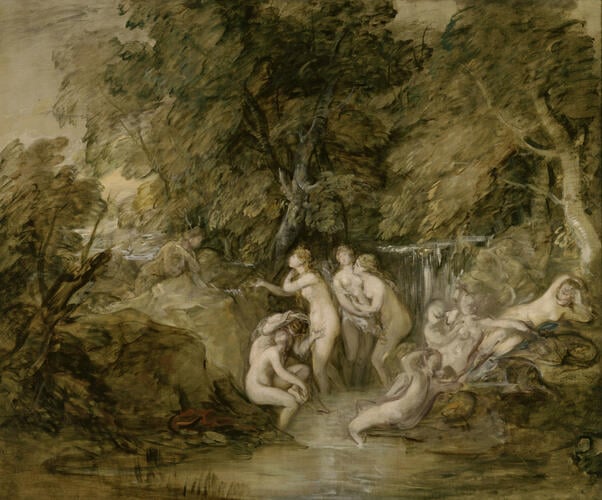-
1 of 253523 objects
Diana and Actaeon c.1785-8
Oil on canvas | 158.1 x 188.0 cm (support, canvas/panel/stretcher external) | RCIN 405077
-
This painting was acquired from the studio sale of Gainsborough Dupont (the artist's nephew) in 1797; it was probably therefore in Gainsborough’s studio at the time of his death in 1788. It is either a finished sketch or an unfinished picture, but its brilliance suggests the former. The Prince of Wales acquired the work for £2 3s, the equivalent of less than £200.00 today. Shortly after its purchase, the work is recorded as having been placed in store at Carlton House.
This is the only surviving mythological painting by Gainsborough. The narrative depicted comes from Book III of Ovid's 'Metamorphoses', in which Actaeon stumbles upon the naked Diana and her nymphs in the act of bathing at a pool. As punishment, the goddess splashed water into his face, turning him into a stag, to be hunted to death by his own hounds.Gainsborough, like many artists before him, has responded to the brief passages of natural description with which Ovid sets the scene for his mythological encounters. Like Titian, whose version c. 1559-75 of this narrative (now in the National Gallery, London) Gainsborough may have known through printed copies, or through the wide reporting of Benjamin West’s rediscovery of the older painting, the artist explores the idea of metamorphosis in the manner in which he has applied his paint: on the left, Actaeon turns from man to beast, in a flurry of lightly hatched strokes; while the female figures seem similarly to borrow qualities from the natural world: their white bodies soft and flowing like water, their hair profuse like foliage.
While the painter’s rapid strokes may suggest a certain speed of execution, the waterfall in the centre of the picture, Anthea Callen notes, was painted ‘wet on dry’. She cites this as evidence that Gainsborough returned to the composition and made the addition of the waterfall, perhaps on discovery of a print after a painting by Filippo Lauri (1623-1694), published in 1764 in London by John Boydell, which features a remarkably similar depiction of a sheet of falling water in the centre of the composition (see Michael Rosenthal, Gainsborough, exhib. cat., Tate, London,2002, p. 280). There is an inherent irony in the idea that this ‘sketch’ is in fact the product of the artist’s careful consolidation of earlier visual sources, as in his repetition of the pose of the reclining nymph on the far right, from a sculpture (known as 'Cleopatra', Vatican Museums). This was expressed most succinctly by Rosenthal, that this was most certainly a work ‘based on art and not life’.
Provenance
Purchased by George IV when Prince of Wales, 1797; recorded in store at Carlton House in 1819 (no 342)
-
Creator(s)
Acquirer(s)
-
Medium and techniques
Oil on canvas
Measurements
158.1 x 188.0 cm (support, canvas/panel/stretcher external)
186.4 x 217.0 x 9.5 cm (frame, external)
Category
Object type(s)
